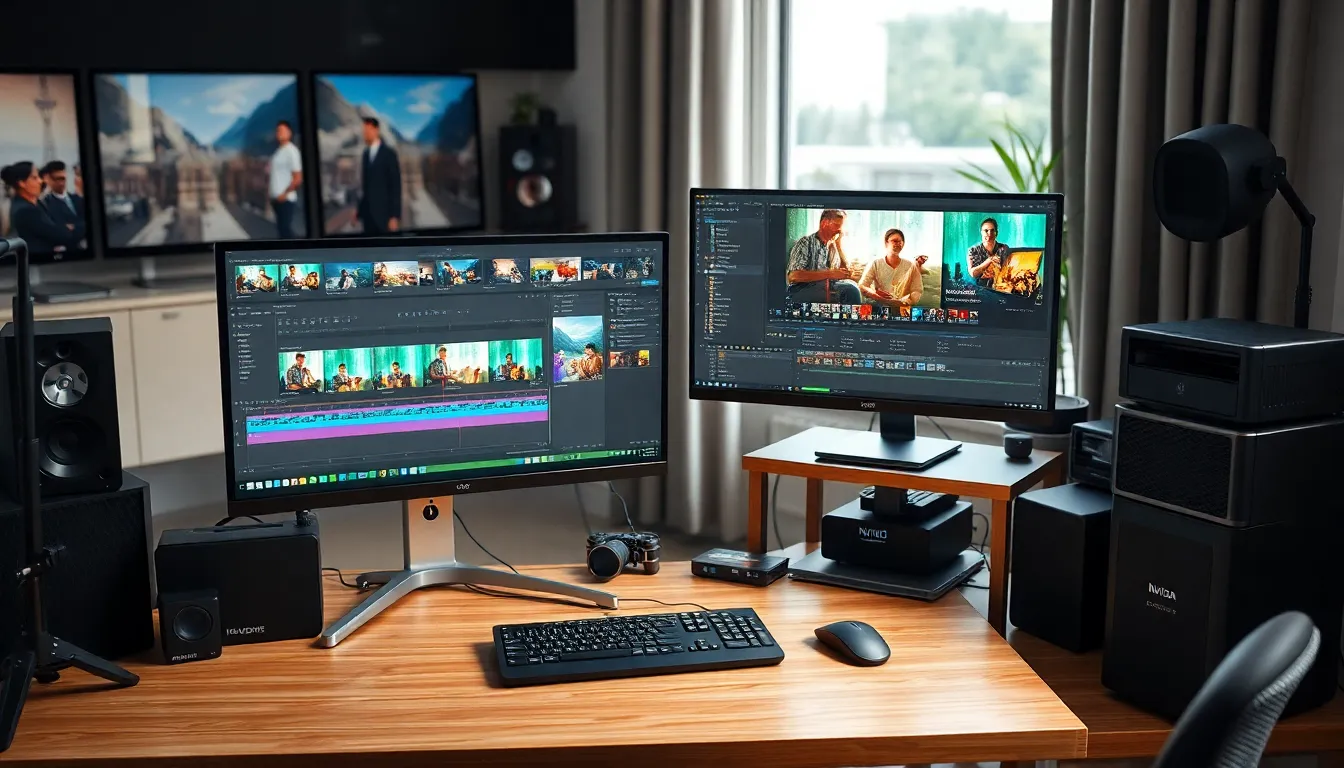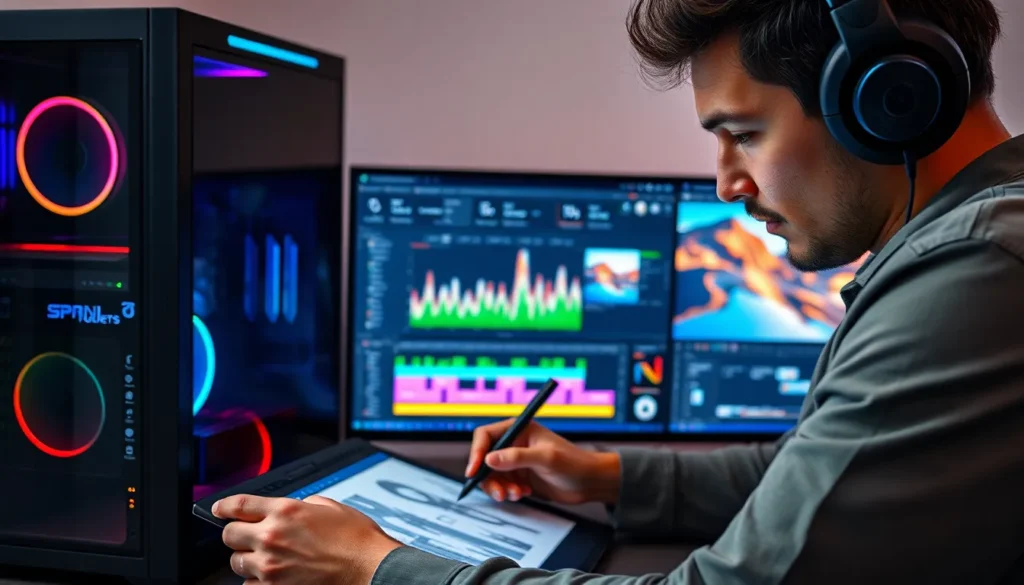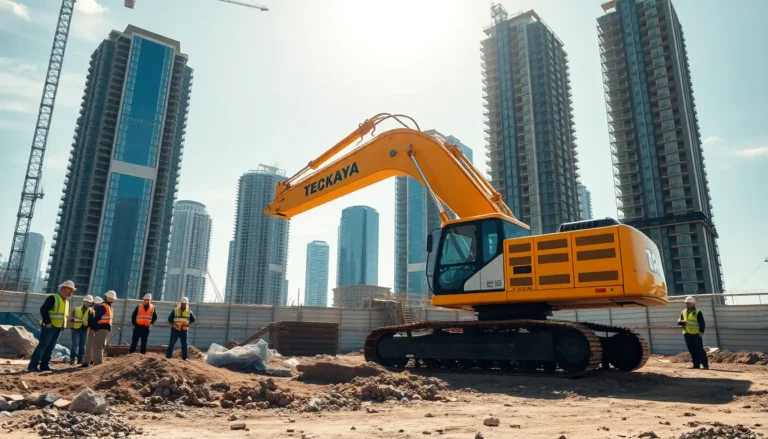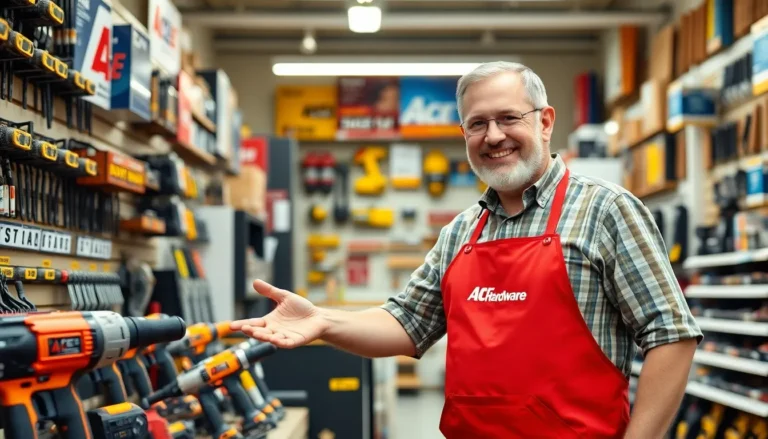Table of Contents
ToggleIn the fast-paced world of content creation, having the right tools can make all the difference. Video editing PCs are essential for both aspiring filmmakers and seasoned professionals, offering the power and performance needed to bring creative visions to life. With high-resolution footage and complex effects becoming the norm, choosing the right hardware is crucial for smooth editing and rendering.
These specialized machines are designed to handle demanding software and large files, ensuring an efficient workflow. From powerful processors to ample storage, understanding what makes a video editing PC stand out can help creators invest wisely. Whether it’s for YouTube, short films, or corporate projects, the right video editing PC can elevate any project to new heights.
Overview of Video Editing PCs
Video editing PCs combine powerful hardware components to handle demanding tasks associated with video production. These specialized machines support high-resolution footage, enabling smooth playback and efficient editing. Key hardware requirements include:
- Processers: Multi-core processors, such as Intel Core i7 or AMD Ryzen 7, deliver improved performance for rendering and multitasking.
- Graphics Cards: Dedicated GPUs, like NVIDIA GeForce RTX series, enhance real-time editing and effects processing.
- RAM: A minimum of 16GB RAM is recommended for seamless performance, although 32GB or more is ideal for complex projects.
- Storage: Solid State Drives (SSDs) improve loading times and project responsiveness, while larger Hard Disk Drives (HDDs) offer ample storage for extensive video libraries.
Video editing software, such as Adobe Premiere Pro or DaVinci Resolve, benefits from these hardware specifications, optimizing workflows and enhancing user experience. Video editing PCs are adaptable, serving various levels of content creators, from beginners to professionals. Entscheidungen regarding configuration should depend on the type of projects undertaken and the software requirements.
Key Features to Consider

Selecting the right components is crucial for optimal performance in video editing PCs. Key features include processor capabilities, RAM and storage needs, and graphics card specifications.
Processor Requirements
Processors power video editing tasks. Multi-core options like Intel Core i7 or AMD Ryzen 7 facilitate smooth playback and quick rendering times. A higher clock speed and more cores enhance multitasking, making it easier to handle high-resolution projects. For demanding software like Adobe Premiere Pro, a processor with at least six cores improves performance and efficiency.
RAM and Storage Needs
RAM affects how many applications can run simultaneously. A minimum of 16GB is essential for standard editing, while 32GB is recommended for complex projects with multiple layers and effects. Storage solutions also impact editing workflows. Solid State Drives (SSDs) provide faster access speeds compared to traditional Hard Disk Drives (HDDs), significantly reducing load times and improving project management. A dual-drive setup, combining SSD for the operating system and primary editing software with HDD for additional storage, optimizes performance further.
Graphics Card Importance
Graphics cards handle rendering and playback of high-resolution footage. Dedicated options like NVIDIA GeForce RTX series offer superior performance compared to integrated graphics, enabling 4K editing and real-time effects preview. The right graphics card enhances software capabilities, making tasks like color grading and visual effects more efficient. Selecting a card with ample VRAM, usually 6GB or more, supports advanced rendering tasks and is ideal for professional-grade video projects.
Top Video Editing PCs on the Market
Content creators can choose from various video editing PCs that cater to both high-end requirements and budget constraints. Each category offers unique specifications essential for optimizing the video editing experience.
High-End Options
High-end video editing PCs provide superior performance, ideal for professionals handling 4K and 8K footage. These systems often feature powerful Intel Core i9 or AMD Ryzen 9 processors, which support advanced multitasking capabilities.
| Brand/Model | Processor | RAM | Graphics Card | Storage |
|---|---|---|---|---|
| Apple Mac Pro | Intel Xeon | 32GB+ | AMD Radeon Pro | 256GB SSD (upgradable) |
| Dell XPS 8950 | Intel Core i9 | 32GB | NVIDIA GeForce RTX 3080 | 1TB SSD |
| HP Z2 Mini G4 | Intel Core i9 | 64GB | NVIDIA Quadro RTX 4000 | 2TB SSD |
| Asus ROG Zephyrus Duo 15 | AMD Ryzen 9 | 32GB | NVIDIA GeForce RTX 3080 | 1TB SSD |
These machines excel in rendering times and playback efficiency, making them critical for tasks like color grading and visual effects. They often include dual drive setups and advanced cooling solutions to maintain performance under heavy workloads.
Budget-Friendly Choices
Budget-friendly video editing PCs deliver respectable performance without excessive costs, suitable for beginners or casual editors. Users can find systems equipped with Intel Core i5 or AMD Ryzen 5 processors, providing adequate power for 1080p editing.
| Brand/Model | Processor | RAM | Graphics Card | Storage |
|---|---|---|---|---|
| Acer Aspire TC-895 | Intel Core i5 | 12GB | NVIDIA GeForce GTX 1650 | 512GB SSD |
| HP Pavilion TP01 | AMD Ryzen 5 | 16GB | AMD Radeon RX 550 | 1TB HDD + 256GB SSD |
| Lenovo IdeaCentre 5 | Intel Core i5 | 16GB | Integrated Intel UHD Graphics | 512GB SSD |
These PCs allow for basic editing tasks with sufficient RAM and storage options. Though not equipped for intensive tasks, they support popular editing software like Adobe Premiere Pro and DaVinci Resolve, ensuring a smooth editing experience for entry-level projects.
Software Compatibility
Selecting a video editing PC hinges on software compatibility, as various editing programs demand specific system requirements. Popular software includes Adobe Premiere Pro, DaVinci Resolve, Final Cut Pro, and Sony Vegas Pro. Each program has preferred specifications, influencing hardware choices.
| Software | Minimum Processor | Recommended Processor | Minimum RAM | Recommended RAM | Minimum Storage | Recommended Storage |
|---|---|---|---|---|---|---|
| Adobe Premiere Pro | Intel Core i5 / AMD Ryzen 5 | Intel Core i7 / AMD Ryzen 7 | 8GB | 16GB | 8GB | SSD |
| DaVinci Resolve | Intel Core i5 / AMD Ryzen 5 | Intel Core i7 / AMD Ryzen 7 | 16GB | 32GB | 100GB | SSD |
| Final Cut Pro | Intel Core i5 | Apple M1 chip | 8GB | 16GB | 256GB | SSD |
| Sony Vegas Pro | Intel Core i5 / AMD Ryzen 5 | Intel Core i7 / AMD Ryzen 7 | 8GB | 16GB | 500GB | SSD |
Choosing the right hardware boosts performance and streamlines workflows. Dedicated graphics cards enhance rendering speeds and playback, particularly for 4K and higher resolutions. Many editing applications leverage GPU acceleration, making a robust graphics setup essential.
Understanding software updates is crucial, as editing programs often introduce new features requiring updated hardware. Staying informed on compatibility ensures users optimize their editing experiences without unexpected issues. Selecting a PC that meets or exceeds software requirements results in efficient performance and fewer disruptions.
Choosing the right video editing PC can make a significant difference in a creator’s workflow and project quality. By investing in powerful hardware tailored to specific editing needs, users can handle demanding software and high-resolution footage with ease. Whether opting for a high-end machine or a budget-friendly option, ensuring compatibility with editing software is crucial for optimal performance.
With the right configuration, content creators can enhance their productivity and creativity, leading to impressive results in their video projects. Taking the time to select the best components will pay off in the long run, allowing for smoother editing experiences and better final products.







